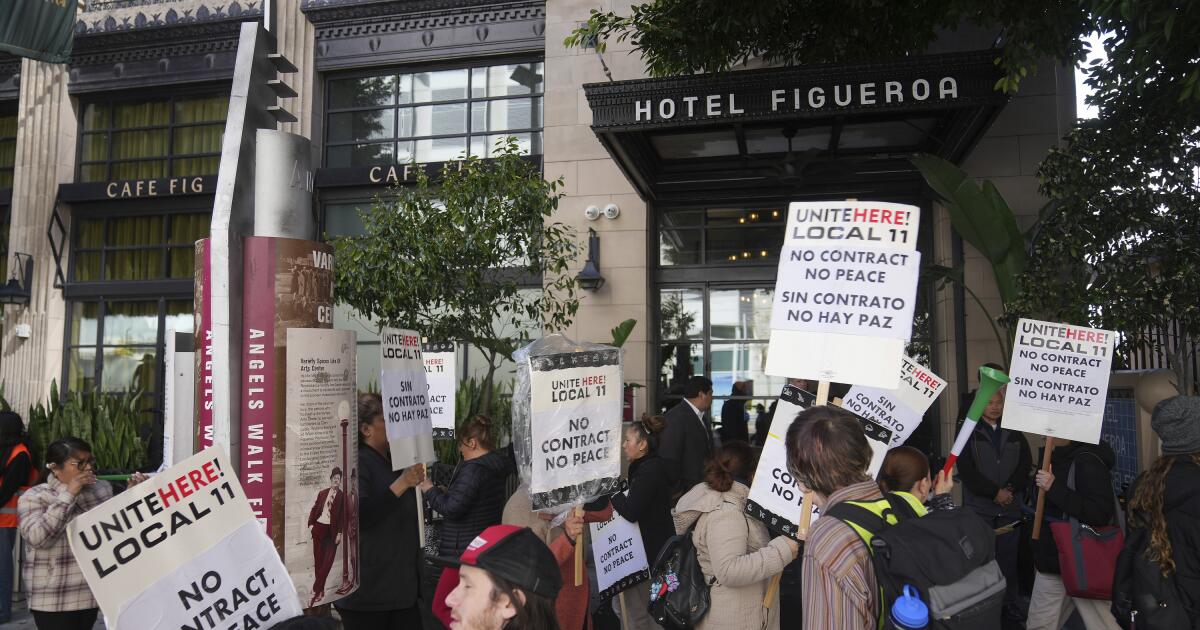With strike behind them, Los Angeles hotels look to move on
On a spring day last year, representatives from dozens of Los Angeles-area hotels gathered for a meeting with the union representing their cleaners, front desk clerks and other workers.
The workers’ contracts with the hotels had expired and leaders from Unite Here Local 11 laid out a stark proposal for new agreements, which included an immediate $5 an hour raise for its members.
It was a nonstarter for the hotel owners and operators — so much so they refused to send their negotiators to the next bargaining session. Weeks of tense negotiations followed and when talks broke down, Unite Here launched a strike thought to be the largest ever to hit the U.S. hotel industry.
The strike’s intermittent work stoppages, which had staff at more than 60 hotels walking off the job, would go on for more than a year. Workers in red shirts sporting drums and horns became a fixture outside of Los Angeles hotels. Picket lines were tumultuous at times and the disruption riled hotel guests, who lashed out at workers.
But now calm has returned. All but a few of the hotels involved in the strike have agreed to new contracts, conceding on the wage increases that had kicked off the strike as well as other demands made by Unite Here. In all, workers are set to receive a total hourly boost of $10 over the course of the four-year contracts.
While the labor unrest roiled a keystone of Southern California’s tourism industry and the new contracts have added to the hotels’ labor costs, hospitality experts said the strike isn’t expected to have a lasting impact on the region’s hotel industry. Hotels have emerged largely unscathed as demand for rooms in the region is healthy and revenue for the hotels climb.
“Right now people have been traveling and I would say hotels are doing well,” said Ed Fuller, a hotel and lodging industry veteran who previously served as Marriott International’s president and now runs an Irvine-based consulting group.
With the strike out of the way, Fuller said the hotel and broader tourism industry should be focused on boosting the number of international tourists back to pre-pandemic levels and “having the commitment that Los Angeles — and Orange County, and San Francisco and the whole state — is selling at all times.”
Upscale hotels in thriving coastal markets, which typically have unionized workforces, are doing relatively well, said Ryan Kawai Sanchez, an associate with real estate firm Matthews.
In particular, occupancy rates at hotels in Los Angeles County averaged more than 70% over the last 12 months, putting the region above the national average of 62.7%, according to data released by the travel industry nonprofit Visit California. The same is true for Orange County.
But not all hotels in the L.A. region are thriving, and location can be a deciding factor. Occupancy rates at the Glendale Hilton, for example, are hovering around 50%, said Travis Gemoets, an attorney at Jeffer, Mangels, Butler & Mitchell, which represents the property. Glendale, Pasadena and other more out-of-the-way areas don’t offer the same draw as more desirable and conveniently located areas such as downtown L.A. and near Los Angeles International Airport.
“It’s just a different market,” Gemoets said.
It was those differences in performance, Gemoets said, that led the Glendale Hilton’s owners to be reluctant to make a deal with Unite Here, since the increased wages the union was demanding would hit the hotel harder than more prosperous properties. The hotel eventually agreed to the wage increase last month, after other hotels in the area reached tentative agreements.
Workers took to the picket line at the Hilton Pasadena in December.
(Myung J. Chun / Los Angeles Times)
“We want labor peace and that’s why we agreed,” Gemoets said.
Union leaders have said they try to extract greater concessions from hotels that prolong negotiations. For instance, in its agreement with Hotel Figueroa, announced last week, the union won an extra dollar raise for non-tipped workers, amounting to a total hourly boost of $11 over the course of the contract, as well as an extra $1 per hour contribution to workers’ pensions. In its deal with the Glendale Hilton, the union secured additional hours for culinary workers and higher pay for tipped workers.
Hotels — whether unionized or not — are battling higher labor costs due to ripple effects from fast-food minimum wage legislation and rising insurance premiums, as multiple insurance providers have abandoned the California market, experts said.
Motels and lower-tier hotels, particularly in California’s rural areas or regions generally with less foot traffic than touristy coastal areas, are lagging behind, Sanchez said. Overall, hotels in the state haven’t completely recovered to pre-pandemic occupancy levels, he said.
“We are really only seeing that year-over-year growth in the luxury sector, and that’s largely due to higher-end customers not being as affected by inflationary pressures as the overall population,” Sanchez said.
Still, “hotels are in pretty darn good shape overall,” said Carl Winston, a professor and director of the hospitality and tourism management program at San Diego State.
Hotel businesses can — and do — pass along added costs to customers, by upping their prices, Winston said. Hotel room rates have gone up dramatically, far exceeding inflation, because it’s the “only thing they can grow.”
“If hotels have a cost increase, they can pass it along to the consumer tomorrow,” Winston said. Hotels change their prices every damn day.”
He said the wage increases built into the new labor agreements are far less of an issue for most major hotels than the debt many of them have taken on, primarily from mortgages with unfavorable interest rates, construction loans and commitments to investors.
“There’s a sense of resignation when it comes to organized labor. It’s almost like, ‘OK, we don’t want them, but they aren’t our biggest threat,’” Winston said. “If you go to hotel boardrooms today, they aren’t talking about wages as an existential threat, it’s the cost of debt they are talking about.”
The lodging industry typically evaluates its health based on two main metrics: occupancy rates and average daily rates.
After rising steeply the last few years, hotel prices in the U.S. this year have remained mostly flat compared with the same time last year, according to data released in April by online booking site Hopper. Higher prices allow businesses to draw in more revenue, but also run the risk of driving away customers.
The median nightly rate for hotels in California this year is $206, a 6% decrease in cost compared with last year’s median of $220, according to data from Kayak. In June, the state’s average daily rate was $192.16, down 0.7% year over year, according to Visit California.
An apparent spike in prices for hotel rooms, Airbnb and other short-term options may show up for California visitors in the coming months, due to a new California law aimed at bringing transparency to resort fees, service fees and hidden prices that jack up a consumer’s bill.
Under the law, businesses must include mandatory fees in their initial advertised prices. Lynn Mohrfeld, president and chief executive of the California Hotel and Lodging Assn., said the group supported the legislation in Sacramento because it should bring “a level playing field” between hotels and the vacation rentals.
“If everybody does it the same way, it makes it a better buying experience for the consumer,” she told The Times earlier this year.
Dealing with the hard numbers of pricing and occupancy rates are a welcome return to normal for hotel owners after the upheaval of the strike.
Unite Here deployed a combination of disruptive tactics — noisy picketing in the early morning, surprise work stoppages, marches through hotel lobbies — that helped put pressure on hotels, said union leaders and hotel industry experts in interviews.
“Hotels were like, ‘This is crazy,’” Bill Doak, of Westwood-based real estate investment firm Stockdale Capital Partners, said of Unite Here Local 11’s demands. Doak’s firm owns the Sandbourne, a Santa Monica hotel that reached a tentative agreement with the union last November. “It was the union’s tactic to make sure hotel owners felt the pain,” Doak said.
Hotels put together contingency staffing plans and told guests they expected to be able to serve them largely without interruption. That proved a difficult task at times.
When workers walked out during the busy Fourth of July weekend, people visiting Disneyland, the Anime Expo downtown and the L.A. leg of Taylor Swift’s Eras tour were greeted outside their hotels by picketing workers banging on drums and blowing vuvuzela horns — of which the union has purchased hundreds.
In online reviews, guests vented frustrations with both hotel management and picketing workers. “If you want to have a peaceful vacation, choose another location,” wrote a tourist who stayed at 1 Hotel West Hollywood in August.
Early on, managers at some hotels realized that the delivery of portable toilets signaled the union’s plans to carry out a work stoppage and protest in front of the property, said Kurt Petersen, Unite Here Local 11 co-president. To confuse them, the union sent toilets to hotels at random.
In January, Unite Here Local 11 organizers took stock of the dozens of hotels that had not yet agreed to new contracts and noticed about 80% were owned by private equity firms or operated by companies owned by such firms.
The union then made more concerted efforts to target companies such as Aimbridge and Blackstone with work stoppages and ramped up efforts to reach out to public pension funds invested in the private equity firms.
“Are those tactics working? Are they getting owners and managers to come to the table? I think the proof is in the results. They are winning right now,” Winston said.








